Film Analysis of Communication in Healthcare: WIT Case Study Report
VerifiedAdded on 2022/09/07
|6
|1390
|21
Report
AI Summary
This report provides a comprehensive analysis of the film 'WIT', focusing on the portrayal of communication within a healthcare setting. The report is divided into two parts. Part 1 examines specific instances of both effective and ineffective therapeutic communication demonstrated by various healthcare professionals, such as doctors and nurses, drawing on relevant literature to support the analysis. The analysis highlights the impact of medical jargon, body language, and the establishment of rapport on patient understanding and comfort. Part 2 offers a personal reflection on the learnings derived from the film, identifying gaps in the understanding of therapeutic communication skills and proposing strategies for improvement, emphasizing the importance of consistent application of these skills and individualized patient care. The report stresses the need for healthcare professionals to consistently apply therapeutic communication strategies to ensure optimal patient outcomes and reduce potential psychological distress.
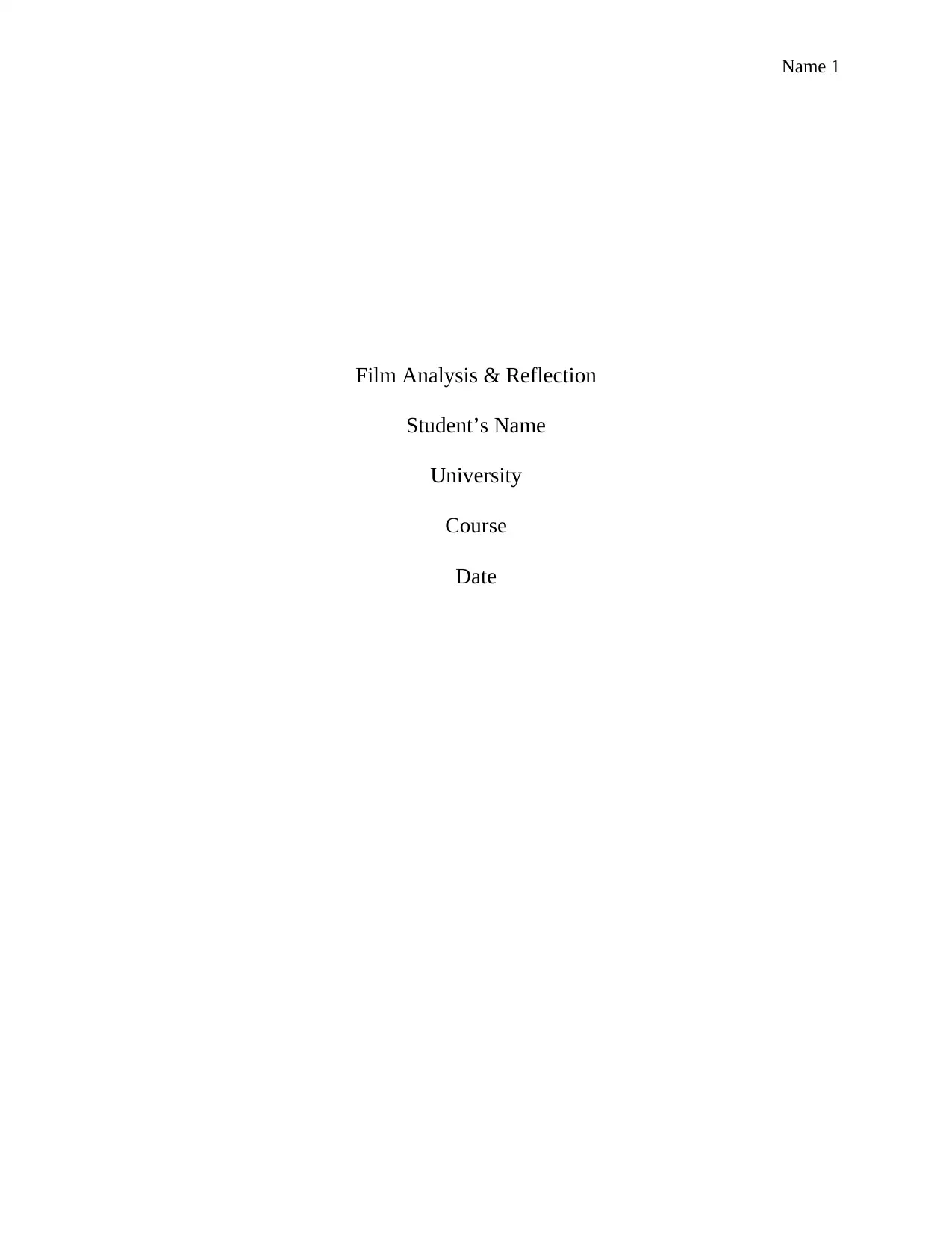
Name 1
Film Analysis & Reflection
Student’s Name
University
Course
Date
Film Analysis & Reflection
Student’s Name
University
Course
Date
Paraphrase This Document
Need a fresh take? Get an instant paraphrase of this document with our AI Paraphraser
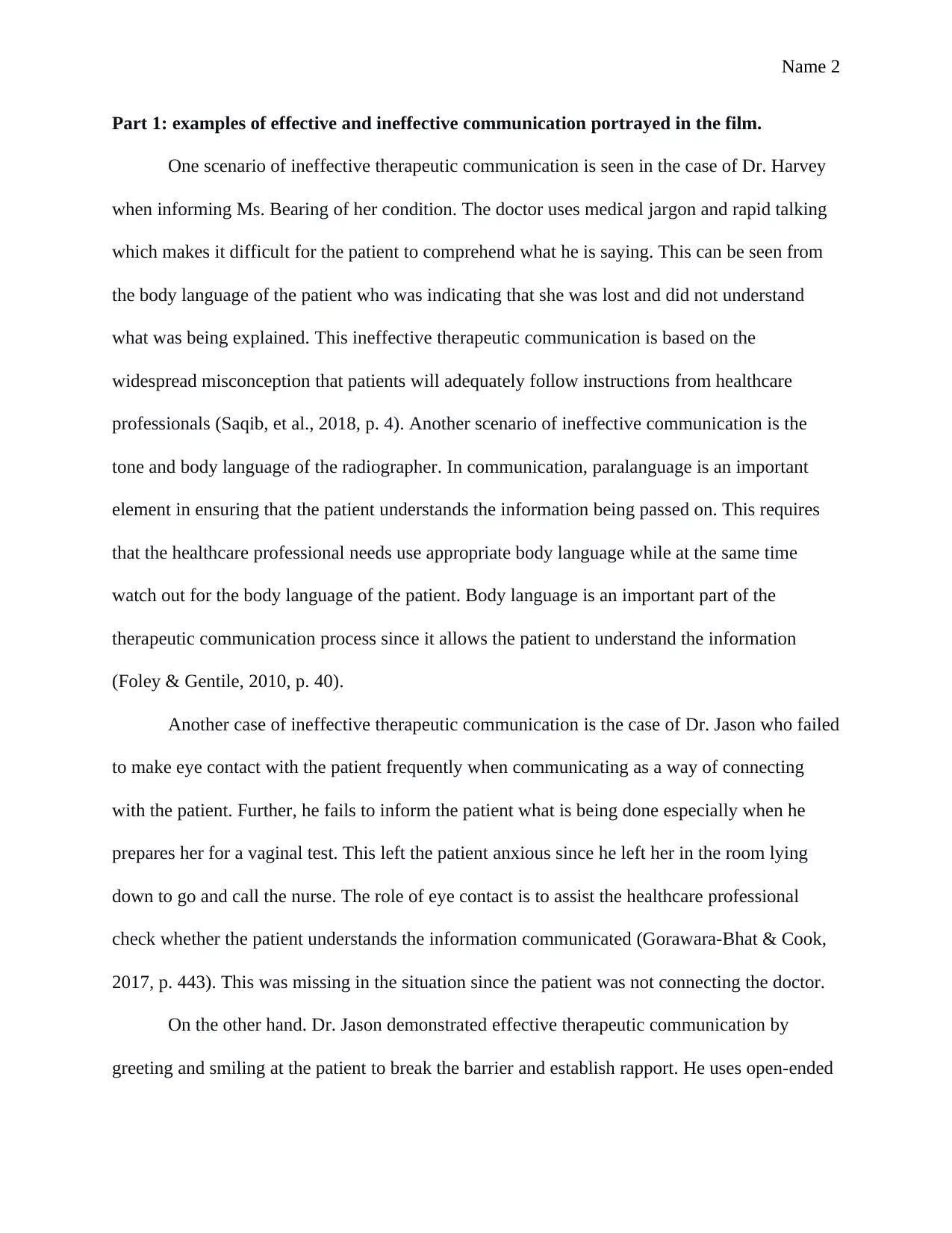
Name 2
Part 1: examples of effective and ineffective communication portrayed in the film.
One scenario of ineffective therapeutic communication is seen in the case of Dr. Harvey
when informing Ms. Bearing of her condition. The doctor uses medical jargon and rapid talking
which makes it difficult for the patient to comprehend what he is saying. This can be seen from
the body language of the patient who was indicating that she was lost and did not understand
what was being explained. This ineffective therapeutic communication is based on the
widespread misconception that patients will adequately follow instructions from healthcare
professionals (Saqib, et al., 2018, p. 4). Another scenario of ineffective communication is the
tone and body language of the radiographer. In communication, paralanguage is an important
element in ensuring that the patient understands the information being passed on. This requires
that the healthcare professional needs use appropriate body language while at the same time
watch out for the body language of the patient. Body language is an important part of the
therapeutic communication process since it allows the patient to understand the information
(Foley & Gentile, 2010, p. 40).
Another case of ineffective therapeutic communication is the case of Dr. Jason who failed
to make eye contact with the patient frequently when communicating as a way of connecting
with the patient. Further, he fails to inform the patient what is being done especially when he
prepares her for a vaginal test. This left the patient anxious since he left her in the room lying
down to go and call the nurse. The role of eye contact is to assist the healthcare professional
check whether the patient understands the information communicated (Gorawara-Bhat & Cook,
2017, p. 443). This was missing in the situation since the patient was not connecting the doctor.
On the other hand. Dr. Jason demonstrated effective therapeutic communication by
greeting and smiling at the patient to break the barrier and establish rapport. He uses open-ended
Part 1: examples of effective and ineffective communication portrayed in the film.
One scenario of ineffective therapeutic communication is seen in the case of Dr. Harvey
when informing Ms. Bearing of her condition. The doctor uses medical jargon and rapid talking
which makes it difficult for the patient to comprehend what he is saying. This can be seen from
the body language of the patient who was indicating that she was lost and did not understand
what was being explained. This ineffective therapeutic communication is based on the
widespread misconception that patients will adequately follow instructions from healthcare
professionals (Saqib, et al., 2018, p. 4). Another scenario of ineffective communication is the
tone and body language of the radiographer. In communication, paralanguage is an important
element in ensuring that the patient understands the information being passed on. This requires
that the healthcare professional needs use appropriate body language while at the same time
watch out for the body language of the patient. Body language is an important part of the
therapeutic communication process since it allows the patient to understand the information
(Foley & Gentile, 2010, p. 40).
Another case of ineffective therapeutic communication is the case of Dr. Jason who failed
to make eye contact with the patient frequently when communicating as a way of connecting
with the patient. Further, he fails to inform the patient what is being done especially when he
prepares her for a vaginal test. This left the patient anxious since he left her in the room lying
down to go and call the nurse. The role of eye contact is to assist the healthcare professional
check whether the patient understands the information communicated (Gorawara-Bhat & Cook,
2017, p. 443). This was missing in the situation since the patient was not connecting the doctor.
On the other hand. Dr. Jason demonstrated effective therapeutic communication by
greeting and smiling at the patient to break the barrier and establish rapport. He uses open-ended
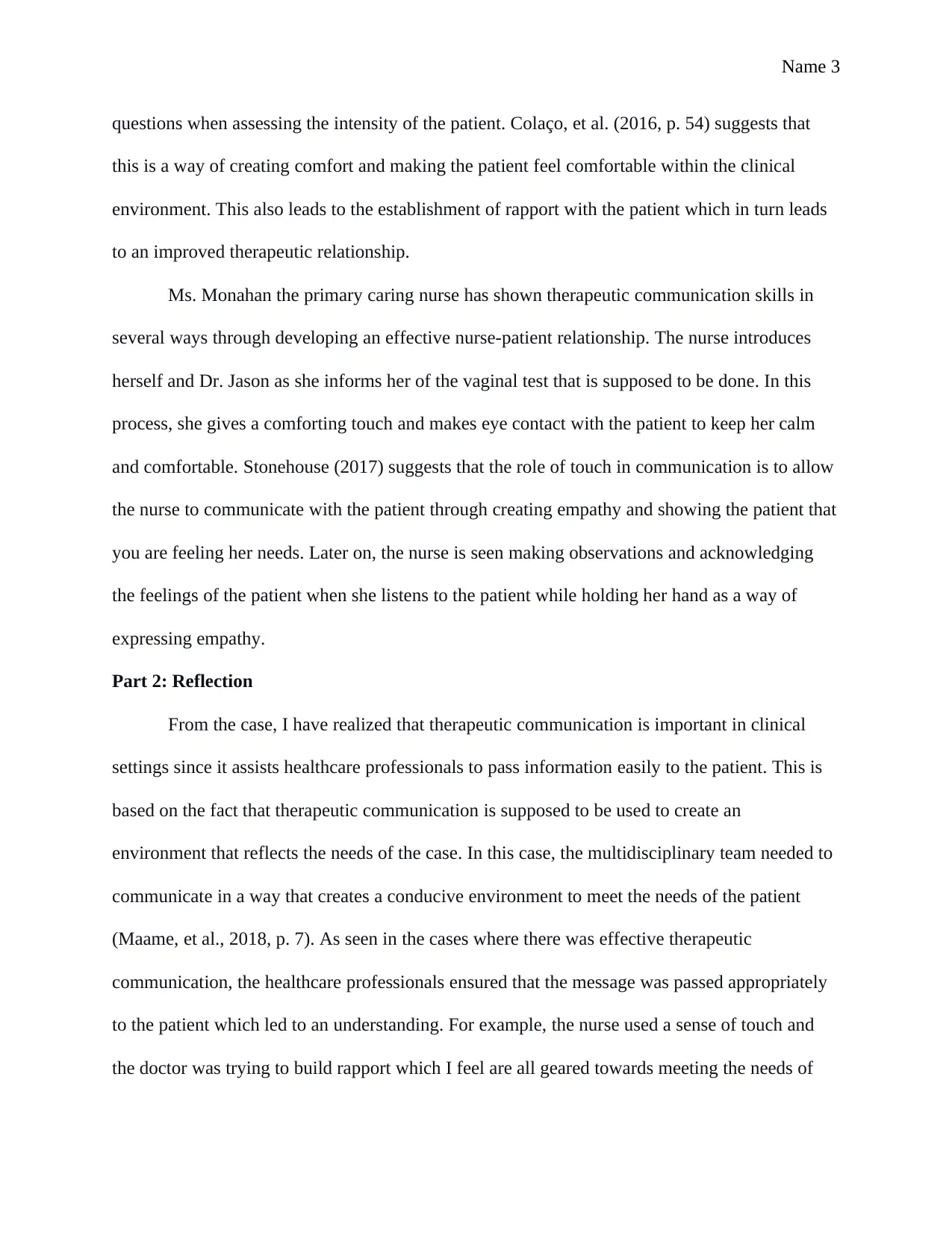
Name 3
questions when assessing the intensity of the patient. Colaço, et al. (2016, p. 54) suggests that
this is a way of creating comfort and making the patient feel comfortable within the clinical
environment. This also leads to the establishment of rapport with the patient which in turn leads
to an improved therapeutic relationship.
Ms. Monahan the primary caring nurse has shown therapeutic communication skills in
several ways through developing an effective nurse-patient relationship. The nurse introduces
herself and Dr. Jason as she informs her of the vaginal test that is supposed to be done. In this
process, she gives a comforting touch and makes eye contact with the patient to keep her calm
and comfortable. Stonehouse (2017) suggests that the role of touch in communication is to allow
the nurse to communicate with the patient through creating empathy and showing the patient that
you are feeling her needs. Later on, the nurse is seen making observations and acknowledging
the feelings of the patient when she listens to the patient while holding her hand as a way of
expressing empathy.
Part 2: Reflection
From the case, I have realized that therapeutic communication is important in clinical
settings since it assists healthcare professionals to pass information easily to the patient. This is
based on the fact that therapeutic communication is supposed to be used to create an
environment that reflects the needs of the case. In this case, the multidisciplinary team needed to
communicate in a way that creates a conducive environment to meet the needs of the patient
(Maame, et al., 2018, p. 7). As seen in the cases where there was effective therapeutic
communication, the healthcare professionals ensured that the message was passed appropriately
to the patient which led to an understanding. For example, the nurse used a sense of touch and
the doctor was trying to build rapport which I feel are all geared towards meeting the needs of
questions when assessing the intensity of the patient. Colaço, et al. (2016, p. 54) suggests that
this is a way of creating comfort and making the patient feel comfortable within the clinical
environment. This also leads to the establishment of rapport with the patient which in turn leads
to an improved therapeutic relationship.
Ms. Monahan the primary caring nurse has shown therapeutic communication skills in
several ways through developing an effective nurse-patient relationship. The nurse introduces
herself and Dr. Jason as she informs her of the vaginal test that is supposed to be done. In this
process, she gives a comforting touch and makes eye contact with the patient to keep her calm
and comfortable. Stonehouse (2017) suggests that the role of touch in communication is to allow
the nurse to communicate with the patient through creating empathy and showing the patient that
you are feeling her needs. Later on, the nurse is seen making observations and acknowledging
the feelings of the patient when she listens to the patient while holding her hand as a way of
expressing empathy.
Part 2: Reflection
From the case, I have realized that therapeutic communication is important in clinical
settings since it assists healthcare professionals to pass information easily to the patient. This is
based on the fact that therapeutic communication is supposed to be used to create an
environment that reflects the needs of the case. In this case, the multidisciplinary team needed to
communicate in a way that creates a conducive environment to meet the needs of the patient
(Maame, et al., 2018, p. 7). As seen in the cases where there was effective therapeutic
communication, the healthcare professionals ensured that the message was passed appropriately
to the patient which led to an understanding. For example, the nurse used a sense of touch and
the doctor was trying to build rapport which I feel are all geared towards meeting the needs of
⊘ This is a preview!⊘
Do you want full access?
Subscribe today to unlock all pages.

Trusted by 1+ million students worldwide
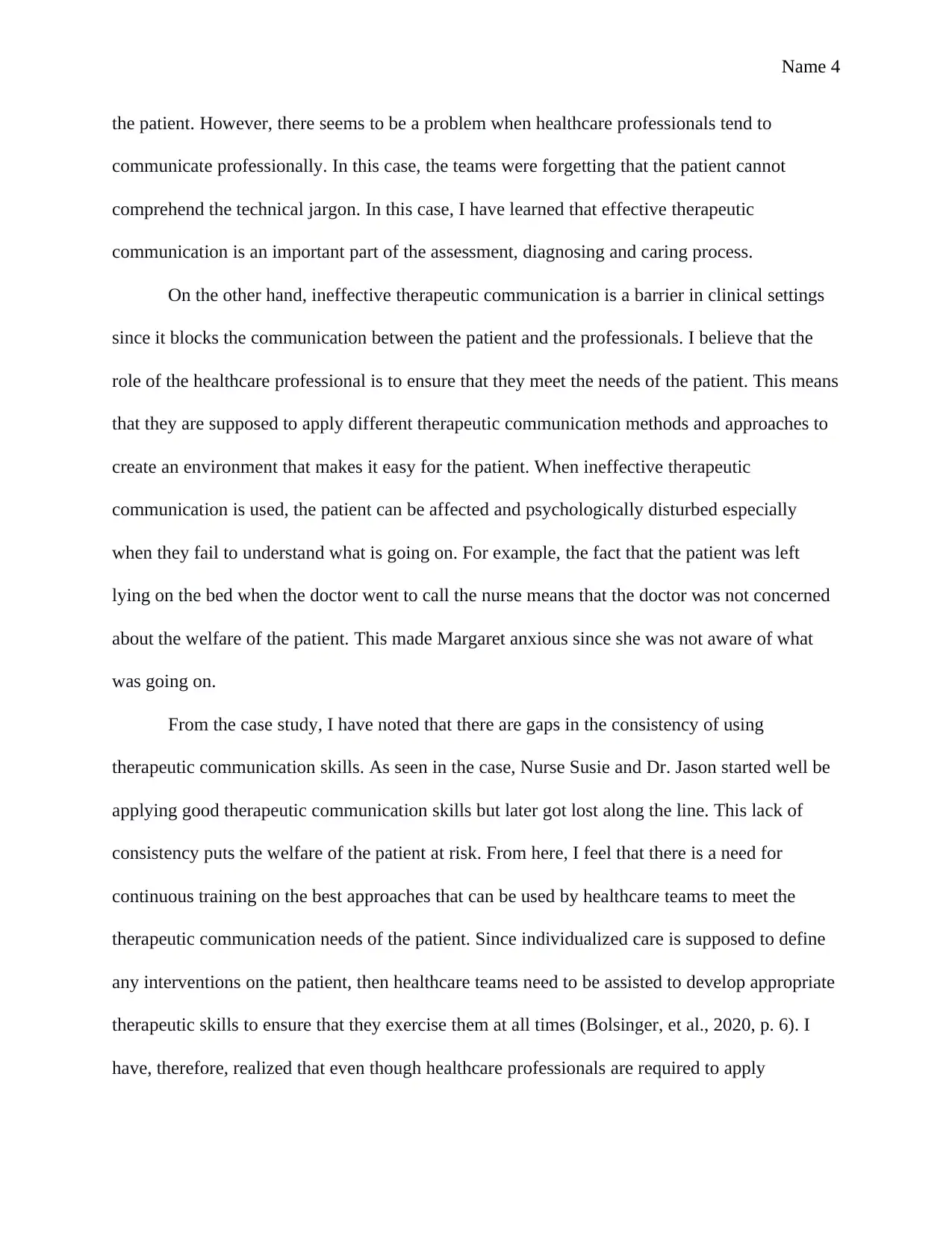
Name 4
the patient. However, there seems to be a problem when healthcare professionals tend to
communicate professionally. In this case, the teams were forgetting that the patient cannot
comprehend the technical jargon. In this case, I have learned that effective therapeutic
communication is an important part of the assessment, diagnosing and caring process.
On the other hand, ineffective therapeutic communication is a barrier in clinical settings
since it blocks the communication between the patient and the professionals. I believe that the
role of the healthcare professional is to ensure that they meet the needs of the patient. This means
that they are supposed to apply different therapeutic communication methods and approaches to
create an environment that makes it easy for the patient. When ineffective therapeutic
communication is used, the patient can be affected and psychologically disturbed especially
when they fail to understand what is going on. For example, the fact that the patient was left
lying on the bed when the doctor went to call the nurse means that the doctor was not concerned
about the welfare of the patient. This made Margaret anxious since she was not aware of what
was going on.
From the case study, I have noted that there are gaps in the consistency of using
therapeutic communication skills. As seen in the case, Nurse Susie and Dr. Jason started well be
applying good therapeutic communication skills but later got lost along the line. This lack of
consistency puts the welfare of the patient at risk. From here, I feel that there is a need for
continuous training on the best approaches that can be used by healthcare teams to meet the
therapeutic communication needs of the patient. Since individualized care is supposed to define
any interventions on the patient, then healthcare teams need to be assisted to develop appropriate
therapeutic skills to ensure that they exercise them at all times (Bolsinger, et al., 2020, p. 6). I
have, therefore, realized that even though healthcare professionals are required to apply
the patient. However, there seems to be a problem when healthcare professionals tend to
communicate professionally. In this case, the teams were forgetting that the patient cannot
comprehend the technical jargon. In this case, I have learned that effective therapeutic
communication is an important part of the assessment, diagnosing and caring process.
On the other hand, ineffective therapeutic communication is a barrier in clinical settings
since it blocks the communication between the patient and the professionals. I believe that the
role of the healthcare professional is to ensure that they meet the needs of the patient. This means
that they are supposed to apply different therapeutic communication methods and approaches to
create an environment that makes it easy for the patient. When ineffective therapeutic
communication is used, the patient can be affected and psychologically disturbed especially
when they fail to understand what is going on. For example, the fact that the patient was left
lying on the bed when the doctor went to call the nurse means that the doctor was not concerned
about the welfare of the patient. This made Margaret anxious since she was not aware of what
was going on.
From the case study, I have noted that there are gaps in the consistency of using
therapeutic communication skills. As seen in the case, Nurse Susie and Dr. Jason started well be
applying good therapeutic communication skills but later got lost along the line. This lack of
consistency puts the welfare of the patient at risk. From here, I feel that there is a need for
continuous training on the best approaches that can be used by healthcare teams to meet the
therapeutic communication needs of the patient. Since individualized care is supposed to define
any interventions on the patient, then healthcare teams need to be assisted to develop appropriate
therapeutic skills to ensure that they exercise them at all times (Bolsinger, et al., 2020, p. 6). I
have, therefore, realized that even though healthcare professionals are required to apply
Paraphrase This Document
Need a fresh take? Get an instant paraphrase of this document with our AI Paraphraser
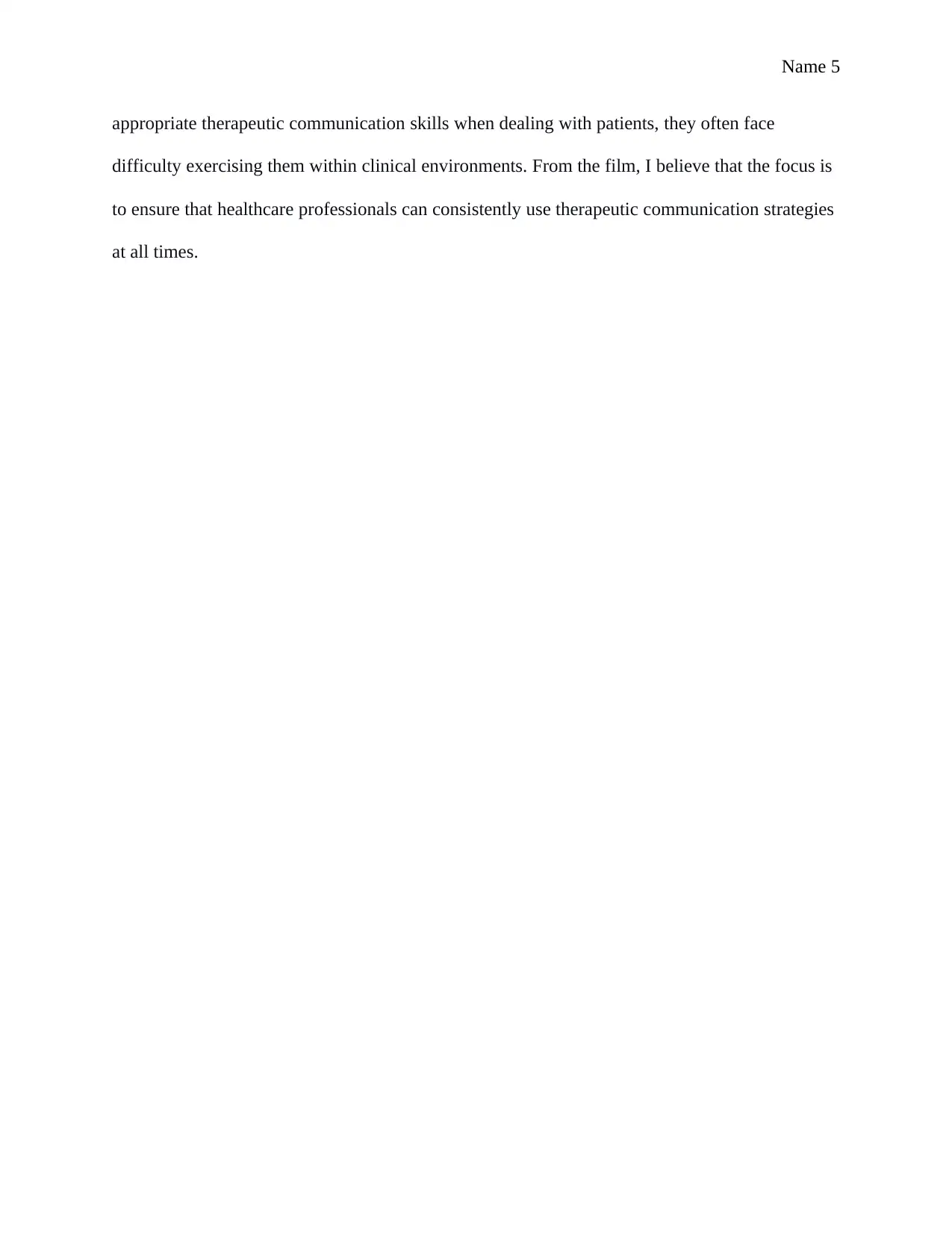
Name 5
appropriate therapeutic communication skills when dealing with patients, they often face
difficulty exercising them within clinical environments. From the film, I believe that the focus is
to ensure that healthcare professionals can consistently use therapeutic communication strategies
at all times.
appropriate therapeutic communication skills when dealing with patients, they often face
difficulty exercising them within clinical environments. From the film, I believe that the focus is
to ensure that healthcare professionals can consistently use therapeutic communication strategies
at all times.
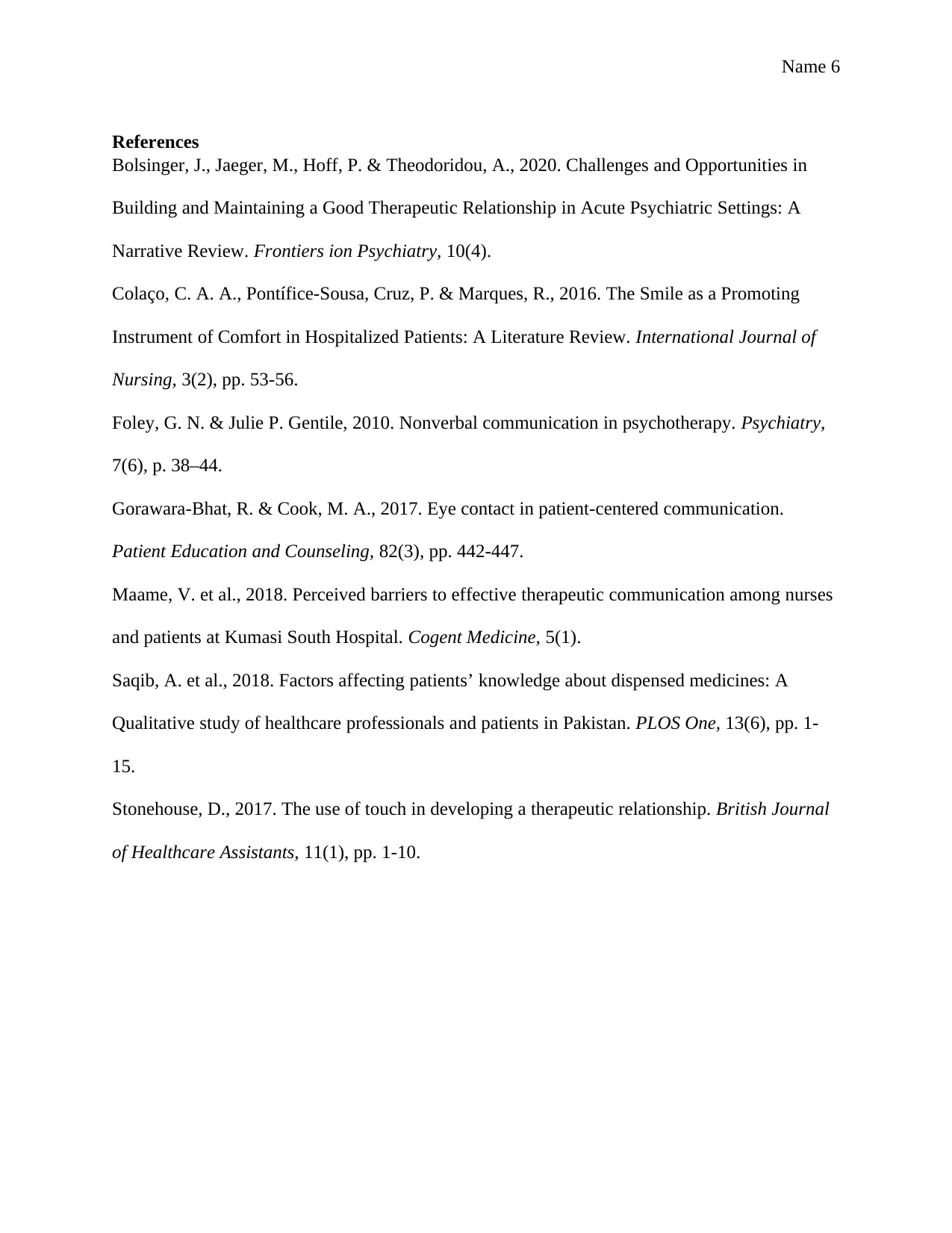
Name 6
References
Bolsinger, J., Jaeger, M., Hoff, P. & Theodoridou, A., 2020. Challenges and Opportunities in
Building and Maintaining a Good Therapeutic Relationship in Acute Psychiatric Settings: A
Narrative Review. Frontiers ion Psychiatry, 10(4).
Colaço, C. A. A., Pontífice-Sousa, Cruz, P. & Marques, R., 2016. The Smile as a Promoting
Instrument of Comfort in Hospitalized Patients: A Literature Review. International Journal of
Nursing, 3(2), pp. 53-56.
Foley, G. N. & Julie P. Gentile, 2010. Nonverbal communication in psychotherapy. Psychiatry,
7(6), p. 38–44.
Gorawara-Bhat, R. & Cook, M. A., 2017. Eye contact in patient-centered communication.
Patient Education and Counseling, 82(3), pp. 442-447.
Maame, V. et al., 2018. Perceived barriers to effective therapeutic communication among nurses
and patients at Kumasi South Hospital. Cogent Medicine, 5(1).
Saqib, A. et al., 2018. Factors affecting patients’ knowledge about dispensed medicines: A
Qualitative study of healthcare professionals and patients in Pakistan. PLOS One, 13(6), pp. 1-
15.
Stonehouse, D., 2017. The use of touch in developing a therapeutic relationship. British Journal
of Healthcare Assistants, 11(1), pp. 1-10.
References
Bolsinger, J., Jaeger, M., Hoff, P. & Theodoridou, A., 2020. Challenges and Opportunities in
Building and Maintaining a Good Therapeutic Relationship in Acute Psychiatric Settings: A
Narrative Review. Frontiers ion Psychiatry, 10(4).
Colaço, C. A. A., Pontífice-Sousa, Cruz, P. & Marques, R., 2016. The Smile as a Promoting
Instrument of Comfort in Hospitalized Patients: A Literature Review. International Journal of
Nursing, 3(2), pp. 53-56.
Foley, G. N. & Julie P. Gentile, 2010. Nonverbal communication in psychotherapy. Psychiatry,
7(6), p. 38–44.
Gorawara-Bhat, R. & Cook, M. A., 2017. Eye contact in patient-centered communication.
Patient Education and Counseling, 82(3), pp. 442-447.
Maame, V. et al., 2018. Perceived barriers to effective therapeutic communication among nurses
and patients at Kumasi South Hospital. Cogent Medicine, 5(1).
Saqib, A. et al., 2018. Factors affecting patients’ knowledge about dispensed medicines: A
Qualitative study of healthcare professionals and patients in Pakistan. PLOS One, 13(6), pp. 1-
15.
Stonehouse, D., 2017. The use of touch in developing a therapeutic relationship. British Journal
of Healthcare Assistants, 11(1), pp. 1-10.
⊘ This is a preview!⊘
Do you want full access?
Subscribe today to unlock all pages.

Trusted by 1+ million students worldwide
1 out of 6
Related Documents
Your All-in-One AI-Powered Toolkit for Academic Success.
+13062052269
info@desklib.com
Available 24*7 on WhatsApp / Email
![[object Object]](/_next/static/media/star-bottom.7253800d.svg)
Unlock your academic potential
Copyright © 2020–2025 A2Z Services. All Rights Reserved. Developed and managed by ZUCOL.





